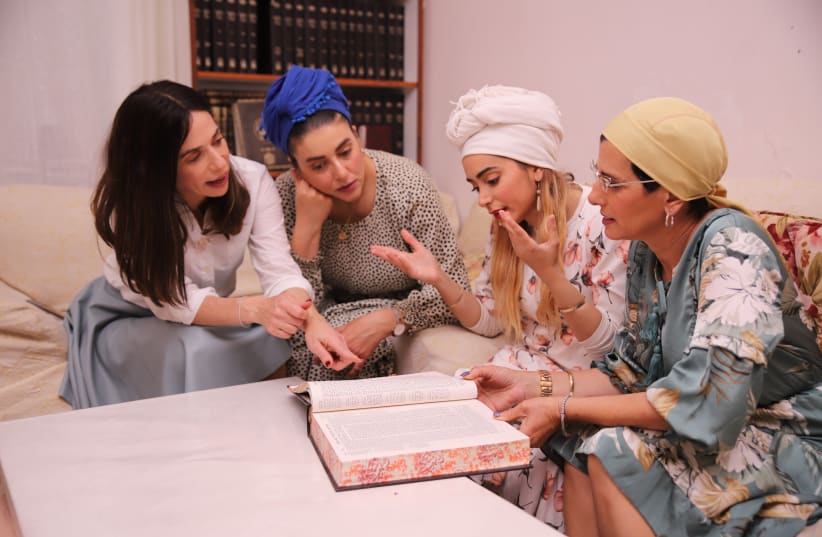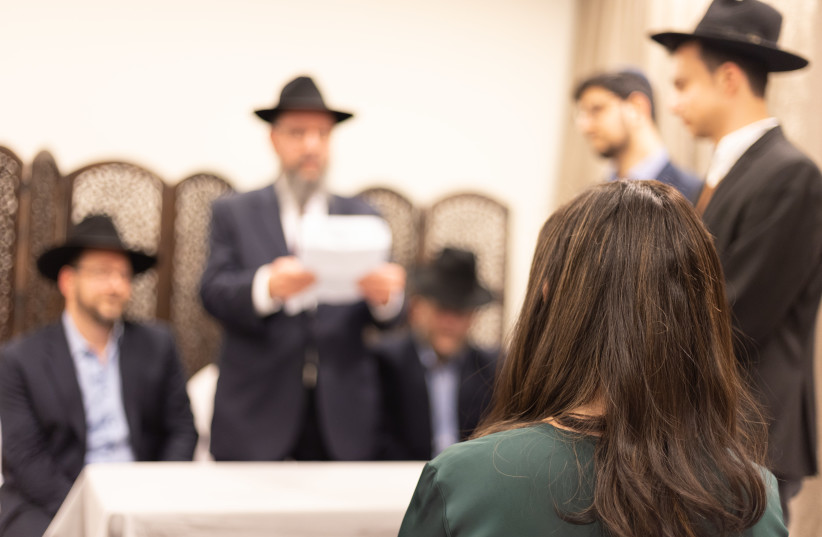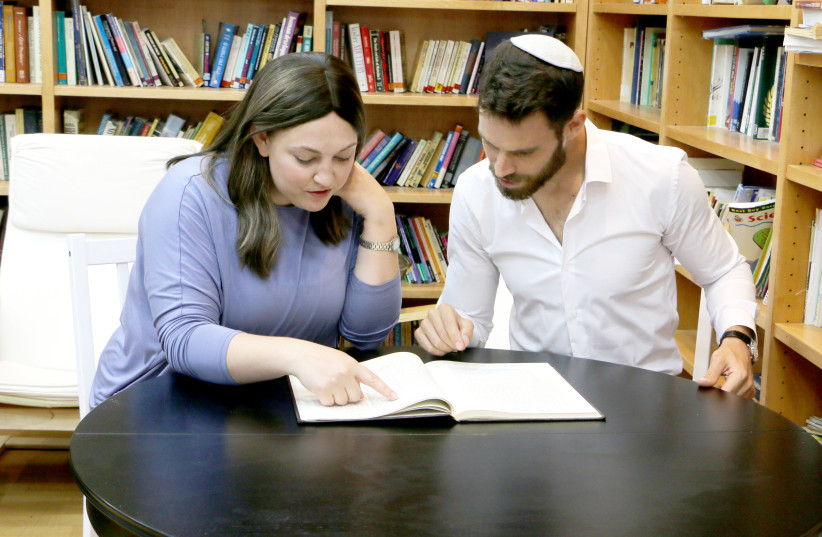Change comes in many forms. It can be legislated by policy or law, it can come via court cases brought by organizations or individuals, or it can be an organic outgrowth of communal desire.
When it comes to women in leadership or influential positions in Judaism in Israel, all three avenues have been responsible for major change, even in the last few years alone.
A country that is both Jewish and democratic, which combines ancient laws and traditions with modern sensibilities and realities, often relies on all three for real change and opportunities
Take for example to’anot (female rabbinical court advocates), women learned in the halachot pertaining to marriage and divorce. Their appearance in rabbinical courts gave women a greater, more knowledgeable voice in the process that determines their marital status, freedom, and even financial settlements and child custody.
Introducing a learned female into the room enabled women to feel more comfortable sharing what they had gone through and learn how best to advocate for themselves. But the first cohort of women, after learning for years in a program designed for this purpose, had to petition the Supreme Court in order to sit for the tests and be certified by the rabbinical courts. Even once they were certified, the Supreme Court had to intervene again to ensure that the rabbinical courts would allow them into the courts. Today, to’anot are a regular and trusted part of the rabbinical courts’ ecosystem, with judges often sending them cases.
Similarly, the 2013 law that mandates at least four women be included in the 11-person committee to elect religious court judges stemmed from a lawsuit filed by the Center for Women’s Justice in 2012, when four seats were automatically saved for men, and no women were elected to the committee. Given that women are half of the petitioners in the rabbinical courts for divorce, they were at a real disadvantage, with only male judges and little female representation or influence over the proceedings.
Moreover, according to one of the first women elected to the committee, the 2013 law replaced the “old boys’ club” approach of electing friends and family members with a more professional process of vetting appropriate candidates.
Other cases brought before the Supreme Court enabled women to serve as CEOs of the rabbinical courts and to be legal assistants to judges.
Prof. Ruth Halperin-Kaddari, head of the Rackman Center, who took part in or headed many of these cases, says, “It is important that women form part of the religious establishment and take part in shaping religious life in Israel. The religious establishment has an influence on all areas of life, and it is vital that it not remain a monopoly of men. It is unthinkable that they alone will make decisions that affect women. Beyond that, it is known that diversity around the decision-making table leads to better decisions.”
“It is important that women form part of the religious establishment and take part in shaping religious life in Israel. The religious establishment has an influence on all areas of life, and it is vital that it not remain a monopoly of men. It is unthinkable that they alone will make decisions that affect women. Beyond that, it is known that diversity around the decision-making table leads to better decisions.”
Prof. Ruth Halperin-Kaddari
Does this desire for women to be in positions of influence reflect communal desire or only that of activists and academics? And are women qualified for such positions or does society sacrifice scholarship and knowledge for equality? Some of these positions require deep knowledge of Jewish law, whether in areas of divorce, such as in the courts; in areas of family purity, death and mourning when on a religious council; and Shabbat and kashrut laws when being a chaplain or guide.
The explosion of women's advanced halachic learning
WOMEN’S ADVANCED learning has exploded, mainly within the dati leumi (Religious Zionist) community, with scores of institutions for higher learning attended by thousands of students, some with women learning full time.
But even if they have the knowledge, some might argue that women are simply not appropriate for such roles, and communities wouldn’t want or trust them in these positions.
This was part of the argument against Leah Shakdiel in 1986 when she was nominated to her local religious council, which manages all religious services, such as marriage licenses, burials, mikvaot, synagogues, and religious programming, and was rejected by the local rabbi and backed by the attorney-general.
A Supreme Court case enabled her election and paved the way for other women to join local councils. Today, according to law, religious councils must comprise at least 30% women. The previous religious affairs minister, Matan Kahana, elected 10 women, including the first haredi women, to head religious councils in 2022.
But these are political positions, and facts on the ground changed because of the law rather than the will of the people. What about halachic leadership when it comes to women? Do these political appointments translate into acceptance by the community?
According to Rabbanit Rachelle Sprecher Fraenkel, head of Hilcheta – Advanced Institute for Halachic Studies at Matan Jerusalem, here too things have changed. “Women are already seen as halachic advisers in much of the community. Yoatzot halacha are an integral part of married couples’ lives. They are advisers and trusted addresses for a generation of couples.”
“Women are already seen as halachic advisers in much of the community. Yoatzot halacha are an integral part of married couples’ lives. They are advisers and trusted addresses for a generation of couples.”
Rabbanit Rachelle Sprecher Fraenkel
Yoatzot halacha, women trained in the laws of niddah and taharat hasmishpacha, which center around a woman’s menstrual cycle, have enabled women around the world to keep the laws that determine when they can be intimate with their husbands, without having to share the most private details of their lives with male rabbis.
Communal acceptance of yoatzot wasn’t universal – and still hasn’t reached the most right-wing communities – but the website and hotline of Nishmat [a center for women’s scholarship in Jerusalem] receive questions from cities such as Lakewood [New Jersey] and Monsey [New York] from women and men of all Jewish streams.
“Some are concerned with a slippery slope when it comes to women’s learning,” says Fraenkel, “but far from a slippery slope, it’s a slow hike up a steep mountain. Halachic learning isn’t for everyone; it’s a very specific type of learning. But for a woman who loves this kind of learning, it’s a natural progression of love of Torah.”
AT THE Rackman Center’s conference on women in Halacha (Jewish law) last month, this was clear.
The conference featured such impressive figures as Rabbanit Dr. Michal Tikochinsky, Malka Puterkovsky, Rabbanit Devorah Evron, and other prominent women and men in the field. Discussions focused on where we have been and where we are going in terms of women’s leadership in Halacha.
Rabbi Levi Cooper, a Magazine columnist, who teaches both law and Jewish studies at Pardes Institute of Jewish Studies, spoke and presented on women’s responsa – the answering of halachic questions. While there are a few books of responsa in print, online is where the real bulk of women’s responsa resides. Among Nishmat’s Women’s Health and Halacha; Matan’s Shayla; Women’s Online Responsa and Halachic insights; and Beit Hillel’s Meshivat Nefesh Project, tens of thousands of halachic questions have been answered by women.
And, according to the presenters at the conference, there is a noticeable difference in the way women answer questions [compared to men].
The responses are often more lengthy; they relate to context, between the lines nuance, and background issues that may not have been explicitly stated but which the rabbanit infers from the way the question was asked or that were so clearly lacking, that they felt the need to fill it in, both for the person who asked and for those who may be reading the Q&A.
Rabbi Herzl Hefter of Rosh Beit Midrash Har’el, a coed Orthodox beit midrash (study hall) in Jerusalem that grants rabbinic ordination to men and women, related to the idea that women’s presence in higher learning had a net positive effect on Torah learning in general. He said, “Much is being said about the nature of women’s Torah learning. That is very meaningful. More important and far-reaching is how Torah learning dialogue between men and women learning together will affect the development of Torah study for the entire Jewish people in the future.”
WHILE COMMUNAL acceptance of women’s halachic scholarship seems to be clearly on the rise, at least in the dati leumi community, the women graduating from these programs still face roadblocks when it comes to recognition for their achievements and the positions they could hold.
As it did with the to’anot, the Rabbinate refuses to allow women to sit for the exams which, when passed, results in certification equivalent to a master’s degree and qualification for certain jobs.
According to the Rabbinate, women halachicly cannot have rabbinic ordination – smicha; and as the exams are for this purpose, women cannot take the exams.
By refusing women the ability to take these tests, the government, via the Rabbinate, is preventing them from receiving the certification, degree recognition, salary increase and qualification for all jobs that require it, such as hospital chaplain, prison chaplain, and regional religious leader.
Letting women take halachic exams
IN 2020, numerous groups, such as The Rackman Center, ITIM and Kolech, petitioned the Supreme Court to allow women to take the exams. The court recommended that the state find a way to open a parallel track for women to allow them to sit for the exams and reach the same status and privileges that these exams provide – i.e., for their learning to count as a degree and, if they pass the exams, be eligible for the jobs.
Various government bodies tossed responsibility back and forth, until Matan Kahana became minister of religious affairs. He took the recommendation seriously, helping to get it done. And so, in November 2022, though Kahana was no longer in the government, 17 women took exams in one of four subjects – Shabbat, niddah, aveilut [mourning], and chuppah & kiddushin [betrothal].
In January, 15 women – 11 from Ohr Torah Stone’s WIHL program and four from Matan Hasharon – for the first time in the history of the state, received recognition from the Religious Services Ministry for their successful completion of the first ever government-administered exam in Halacha (Jewish law).
Will the recognition of the state be recognized by the community? Rabbanit Evron says, “The dati [religious] community knows that there are morot halacha, rabbaniot and accepts them. They ask questions of them. Rabbaniot sit on the halachic committee of Beit Hillel – a collective of male and female Orthodox rabbis and scholars. There are more rabbaniot of schools and high schools in place of rabbis. One of the WIHL graduates even teaches Halacha in a men’s yeshiva.”
A question that comes to mind is, if women learn exactly as men do, and sit for these same exams, are we losing out on other angels of Torah study? Of new ways of combining information and other subjects to tap into deeply?
Evron stresses that in a number of these programs, the learning includes modern application. “Women in WIHL [Women’s Institute of Halachic Leadership] must take courses parallel to Halacha. For example, how to deal with mourning in ethics and of life; philosophy of pain; the donation of organs; how the chevra kadisha [burial society] works. How to help a family go from death to the funeral; issues that will come up during the shiva mourning period [the week after a person’s funeral] and the shloshim [month of mourning following the funeral]; what happens when a family is estranged; what about step siblings, what if some are abroad; what if there are only daughters; what are the rules for women in mourning.
“These courses are intentionally put into the programs. Often, it is only after rabbis go into the field that they realize they are lacking practical pastoral applications. We have learned to incorporate these into the program from the start.”
Ravit Kalech, one of the women who passed the exams, says, “As a lawyer, it was obvious for me that in the same way I took the bar exams, which test knowledge and understanding of the laws of Israel... I should be entitled to take the halachic exams, which test knowledge and understanding of the Jewish law, the Halacha, in a variety of subjects. Personally, I prefer to study lishma [for its sake], which enables me to study as much as I want ...without having the pressure and intensity of the exams. But I took these exams because it is important to have the same method of tests for the studies and knowledge in Halacha.”
As proposed judicial reforms rock the country, and as the new religious affairs minister has just frozen the women's testing track, many wonder what will become of the above advancements in women’s certification and eligibility for positions. What will happen if the government succeeds in reducing the power of the courts to enable women’s learning to be recognized and certified? Will we go backward and bar women from rabbinic courts and religious councils?
We cannot know; but it is safe to say that whatever happens legally, the government cannot stop the community from turning to learned women for the advice and knowledge they have gained and are willing to share. In a country that is feeling the tensions of being both Jewish and democratic, whose growing pains are evident in the streets during week after week of protests against proposed judicial reform, it is clear that community will play a strong part in what will be achieved and what will be tolerated. ■


